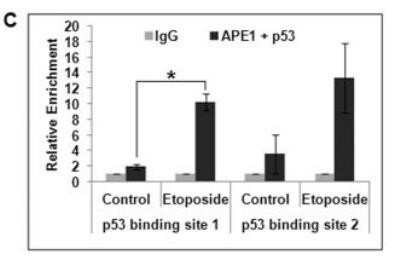APE Antibody (13B8E5C2) - Azide and BSA Free
Novus Biologicals, part of Bio-Techne | Catalog # NBP2-80578

![Western Blot: APE Antibody (13B8E5C2)Azide and BSA Free [NBP2-80578] Western Blot: APE Antibody (13B8E5C2)Azide and BSA Free [NBP2-80578]](https://resources.bio-techne.com/images/products/APE-Antibody-13B8E5C2-Azide-and-BSA-Free-Western-Blot-NBP2-80578-img0002.jpg)
Conjugate
Catalog #
Forumulation
Catalog #
Key Product Details
Validated by
Knockout/Knockdown, Biological Validation
Species Reactivity
Human, Mouse, Rat, Primate
Applications
Chromatin Immunoprecipitation (ChIP), Gel Super Shift Assays, Immunoblotting, Immunocytochemistry/ Immunofluorescence, Immunohistochemistry, Immunohistochemistry-Frozen, Immunohistochemistry-Paraffin, Immunoprecipitation, Knockdown Validated, Proximity Ligation Assay, Simple Western, Western Blot
Label
Unconjugated
Antibody Source
Monoclonal Mouse IgG2B Clone # 13B8E5C2
Format
Azide and BSA Free
Concentration
1 mg/ml
Product Specifications
Immunogen
Purified human APE1
Epitope
The epitope is within amino acids 80-100.
Localization
In immunohistochemical experiments punctate nuclear staining is observed in most cell types. Cytoplasmic staining may be seen in hepatocytes, large neurons and granule cells.
Clonality
Monoclonal
Host
Mouse
Isotype
IgG2B
Theoretical MW
37 kDa.
Disclaimer note: The observed molecular weight of the protein may vary from the listed predicted molecular weight due to post translational modifications, post translation cleavages, relative charges, and other experimental factors.
Disclaimer note: The observed molecular weight of the protein may vary from the listed predicted molecular weight due to post translational modifications, post translation cleavages, relative charges, and other experimental factors.
Scientific Data Images for APE Antibody (13B8E5C2) - Azide and BSA Free
Western Blot: APE Antibody (13B8E5C2)Azide and BSA Free [NBP2-80578]
Western Blot: APE Antibody (13B8E5C2) - Azide and BSA Free [NBP2-80578] - Whole cell protein from human HeLa, A431, mouse Neuro2A and rat PC12 cells was separated on a 12% gel by SDS-PAGE, transferred to PVDF membrane and blocked in 5% non-fat milk in TBST. The membrane was probed with 2.0 ug/mL anti-APE-1 in block buffer and detected with an anti-mouse HRP secondary antibody using chemiluminescence. Image from the standard format of this antibody.Immunocytochemistry: APE Antibody (13B8E5C2) - Azide and BSA Free [NBP2-80578]
Immunocytochemistry: APE Antibody (13B8E5C2) - Azide and BSA Free [NBP2-80578] - Immunohistochemical staining of APE1. A. Nuclear staining in the luminal epithelium of normal breast ducts and lobules. B. Low, and C. high nuclear APE1 expression in invasive breast cancer. (magnification x400). Image collected and cropped by CiteAb fromImmunohistochemistry: APE Antibody (13B8E5C2) - Azide and BSA Free [NBP2-80578]
Immunohistochemistry: APE Antibody (13B8E5C2) - Azide and BSA Free [NBP2-80578] - APE1 antibody was tested in human breast cancer xenograft using DAB with hematoxylin counterstain. Image from the standard format of this antibody.Applications for APE Antibody (13B8E5C2) - Azide and BSA Free
Application
Recommended Usage
Chromatin Immunoprecipitation (ChIP)
1:10-1:500
Gel Super Shift Assays
reported in scientific literature
Immunoblotting
reported in scientific literature (PMID 27608656)
Immunocytochemistry/ Immunofluorescence
1:50 - 1:200
Immunohistochemistry
1:100
Immunohistochemistry-Frozen
1:10 - 1:500
Immunohistochemistry-Paraffin
1:100
Immunoprecipitation
1:10 - 1:500
Proximity Ligation Assay
reported in scientific literature (PMID 27808278)
Simple Western
1:25
Western Blot
1:100 - 1:2000
Application Notes
In Western blot, this antibody detects a single band at 37 kDa. In IHC, it can be competitively inhibited from recognizing the APE1 antigen in tissues using APE1 protein. It can also be used on frozen and fixed-paraffin sections and cytospin preps. In IHC-P, staining was observed in the nucleus of a human breast cancer xenograft. Prior to immunostaining paraffin tissues, antigen retrieval with sodium citrate buffer (pH 6.0) is recommended. In Simple Western only 10 - 15 uL of the recommended dilution is used per data point.
See Simple Western Antibody Database for Simple Western validation: antibody dilution of 1:25. Separated by Size-Wes, Sally Sue/Peggy Sue.
See Simple Western Antibody Database for Simple Western validation: antibody dilution of 1:25. Separated by Size-Wes, Sally Sue/Peggy Sue.
Formulation, Preparation, and Storage
Purification
Protein G purified
Formulation
PBS
Format
Azide and BSA Free
Preservative
No Preservative
Concentration
1 mg/ml
Shipping
The product is shipped with polar packs. Upon receipt, store it immediately at the temperature recommended below.
Stability & Storage
Store at 4C short term. Aliquot and store at -20C long term. Avoid freeze-thaw cycles.
Background: APE
Long Name
Apurinic/Apyrimidinic Endonuclease
Alternate Names
APEX1
Gene Symbol
APEX1
Additional APE Products
Product Documents for APE Antibody (13B8E5C2) - Azide and BSA Free
Product Specific Notices for APE Antibody (13B8E5C2) - Azide and BSA Free
This product is for research use only and is not approved for use in humans or in clinical diagnosis. Primary Antibodies are guaranteed for 1 year from date of receipt.
Loading...
Loading...
Loading...
Loading...
![Immunocytochemistry: APE Antibody (13B8E5C2) - Azide and BSA Free [NBP2-80578] Immunocytochemistry: APE Antibody (13B8E5C2) - Azide and BSA Free [NBP2-80578]](https://resources.bio-techne.com/images/products/APE-Antibody-13B8E5C2-Azide-and-BSA-Free-Immunocytochemistry-NBP2-80578-img0006.jpg)
![Immunohistochemistry: APE Antibody (13B8E5C2) - Azide and BSA Free [NBP2-80578] Immunohistochemistry: APE Antibody (13B8E5C2) - Azide and BSA Free [NBP2-80578]](https://resources.bio-techne.com/images/products/APE-Antibody-13B8E5C2-Azide-and-BSA-Free-Immunohistochemistry-NBP2-80578-img0007.jpg)

![Western Blot: APE Antibody (13B8E5C2)Azide and BSA Free [NBP2-80578] Western Blot: APE Antibody (13B8E5C2)Azide and BSA Free [NBP2-80578]](https://resources.bio-techne.com/images/products/APE-Antibody-13B8E5C2-Azide-and-BSA-Free-Western-Blot-NBP2-80578-img0001.jpg)
![Immunocytochemistry/ Immunofluorescence: APE Antibody (13B8E5C2) - Azide and BSA Free [NBP2-80578] Immunocytochemistry/ Immunofluorescence: APE Antibody (13B8E5C2) - Azide and BSA Free [NBP2-80578]](https://resources.bio-techne.com/images/products/APE-Antibody-13B8E5C2-Azide-and-BSA-Free-Immunocytochemistry-Immunofluorescence-NBP2-80578-img0003.jpg)
![Immunocytochemistry/ Immunofluorescence: APE Antibody (13B8E5C2) - Azide and BSA Free [NBP2-80578] Immunocytochemistry/ Immunofluorescence: APE Antibody (13B8E5C2) - Azide and BSA Free [NBP2-80578]](https://resources.bio-techne.com/images/products/APE-Antibody-13B8E5C2-Azide-and-BSA-Free-Immunocytochemistry-Immunofluorescence-NBP2-80578-img0004.jpg)
![Immunocytochemistry: APE Antibody (13B8E5C2) - Azide and BSA Free [NBP2-80578] Immunocytochemistry: APE Antibody (13B8E5C2) - Azide and BSA Free [NBP2-80578]](https://resources.bio-techne.com/images/products/APE-Antibody-13B8E5C2-Azide-and-BSA-Free-Immunocytochemistry-NBP2-80578-img0005.jpg)
![Simple Western: APE Antibody (13B8E5C2)Azide and BSA Free [NBP2-80578] Simple Western: APE Antibody (13B8E5C2)Azide and BSA Free [NBP2-80578]](https://resources.bio-techne.com/images/products/APE-Antibody-13B8E5C2-Azide-and-BSA-Free-Simple-Western-NBP2-80578-img0010.jpg)
![Western Blot: APE Antibody (13B8E5C2) - Azide and BSA Free [NBP2-80578] Knockdown Validated: APE Antibody (13B8E5C2) - Azide and BSA Free [NBP2-80578]](https://resources.bio-techne.com/images/products/APE-Antibody-13B8E5C2-Azide-and-BSA-Free-Knockdown-Validated-NBP2-80578-img0009.jpg)